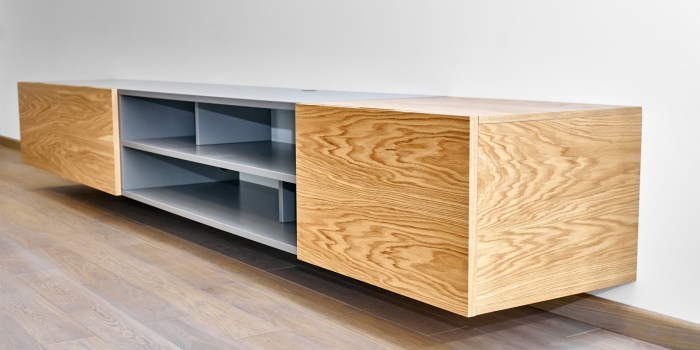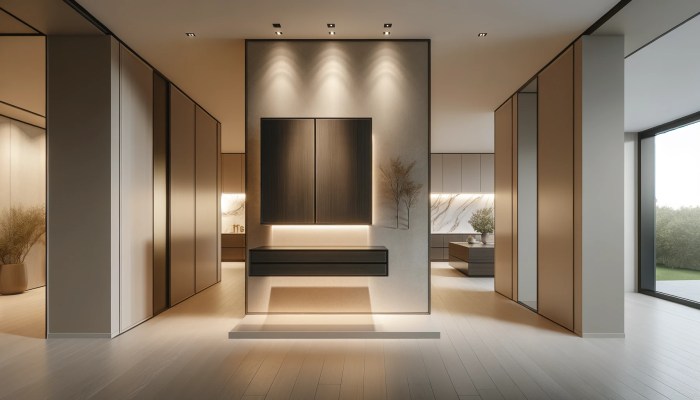Floating cabinet furniture for entry walls offers a stylish and space-saving solution for enhancing your home’s entrance. These versatile pieces seamlessly blend functionality with aesthetics, providing practical storage while adding a touch of modern elegance. From sleek minimalist designs to more ornate styles, the options are diverse, allowing you to personalize your entryway to reflect your unique taste and enhance the overall ambiance of your home.
Consider the available space, desired storage capacity, and your existing décor when selecting the perfect floating cabinet.

The strategic placement of a floating cabinet can dramatically impact the entryway’s visual appeal. A well-chosen cabinet can create a focal point, drawing the eye and establishing a welcoming atmosphere. Furthermore, the concealed storage provided helps to maintain a clean and organized space, minimizing clutter and maximizing the sense of openness. The variety of materials, finishes, and sizes ensures compatibility with various interior design styles, from contemporary to traditional.
Entryways often feel like neglected spaces, mere transitions between the outside world and the comfort of your home. However, a thoughtfully designed entryway can dramatically enhance the overall aesthetic and functionality of your living space. Floating cabinets, with their sleek lines and space-saving design, are rapidly becoming a popular choice for maximizing entryway storage and style. This comprehensive guide explores the benefits, styles, considerations, and installation of floating cabinets for entry walls, helping you transform your entryway into a welcoming and organized haven.
Why Choose Floating Cabinets for Your Entryway?
Floating cabinets offer several compelling advantages for entryway design:
- Space-Saving Design: Unlike traditional cabinets, floating cabinets don’t require floor space, making them ideal for smaller entryways or hallways.
- Modern Aesthetic: Their sleek, minimalist design adds a touch of contemporary elegance to any entryway.
- Enhanced Organization: They provide valuable storage for keys, mail, wallets, and other everyday essentials, keeping your entryway clutter-free.
- Versatile Styling: Floating cabinets are available in a wide range of materials, colors, and styles, allowing for seamless integration with your existing décor.
- Easy Access: Items are easily accessible, unlike cabinets tucked away in corners or behind doors.
Types of Floating Cabinets for Entryways
The market offers a diverse range of floating cabinets to suit various needs and preferences:
Based on Material:
- Wood: Offers warmth, durability, and a classic appeal. Consider options like oak, maple, or cherry, each with unique grain patterns and color tones.
- Metal: Provides a modern, industrial look. Steel or aluminum cabinets offer strength and a clean, minimalist aesthetic.
- Glass: Adds a touch of elegance and allows for a glimpse of stored items. Perfect for showcasing decorative items or displaying keys.
- Composite Materials: These offer a blend of durability and affordability. Materials like MDF (Medium-Density Fiberboard) or particleboard are often used, often with a veneer finish.
Based on Style:, Floating cabinet furniture for entry walls
- Minimalist: Clean lines, simple designs, and neutral colors.
- Rustic: Reclaimed wood, distressed finishes, and visible wood grain.
- Modern: Sleek designs, metallic accents, and bold colors.
- Traditional: Ornate details, classic moldings, and warm wood tones.
Based on Functionality:
- Open Shelving: Ideal for displaying decorative items or frequently used items.
- Closed Cabinets: Offer concealed storage for a cleaner, more organized look.
- Combination Units: Integrate both open and closed storage for optimal functionality.
- Cabinets with Drawers: Provide additional storage space for smaller items.
Choosing the Right Floating Cabinet for Your Entryway
Selecting the perfect floating cabinet involves considering several factors:
- Space Available: Measure your entryway carefully to determine the ideal size and configuration of your cabinet.
- Storage Needs: Consider the items you need to store and choose a cabinet with appropriate shelving and storage options.
- Style and Design: Select a cabinet that complements your existing décor and personal style.
- Material and Durability: Choose a material that is durable, easy to clean, and resistant to wear and tear.
- Budget: Set a budget before you start shopping to avoid overspending.
- Installation: Consider the complexity of installation and whether you need professional help.
Installing Floating Cabinets: A Step-by-Step Guide
While professional installation is always an option, many floating cabinets can be installed with basic DIY skills. However, always prioritize safety and consult the manufacturer’s instructions. Improper installation can lead to damage or injury.
- Plan the Placement: Carefully measure and mark the desired location for your cabinet.
- Locate Studs: Use a stud finder to locate wall studs for secure mounting. This is crucial for supporting the weight of the cabinet and its contents.
- Prepare the Wall: Clean the wall surface to ensure proper adhesion of the mounting hardware.
- Mount the Brackets: Attach the mounting brackets to the wall studs using appropriate screws and anchors.
- Attach the Cabinet: Carefully hang the cabinet onto the mounted brackets.
- Level and Secure: Ensure the cabinet is level and securely attached to the brackets.
- Q: How much weight can a floating cabinet hold? A: This varies greatly depending on the cabinet’s material, size, and mounting hardware. Always check the manufacturer’s specifications for weight capacity.
- Q: Can I install a floating cabinet on drywall? A: Yes, but you’ll need to use appropriate drywall anchors to ensure secure mounting. Consider using heavy-duty anchors for larger or heavier cabinets.
- Q: How do I clean a floating cabinet? A: Cleaning methods depend on the cabinet’s material. Generally, a damp cloth and mild detergent are sufficient. Avoid harsh chemicals or abrasive cleaners.
- Q: What are some creative ways to use floating cabinets in my entryway? A: Use them for storing shoes, coats, bags, keys, mail, plants, or decorative items. You can even incorporate lighting to highlight the cabinet and its contents.
- Q: Are floating cabinets difficult to install? A: The difficulty level depends on the cabinet’s design and your DIY skills. Some simpler models are relatively easy to install, while others may require more expertise.
- Home Depot (for cabinet options and supplies)
- Lowe’s (for cabinet options and supplies)
- Family Handyman (for DIY installation guides)
Frequently Asked Questions (FAQs)
Resources: Floating Cabinet Furniture For Entry Walls
Conclusion
Floating cabinets offer a stylish and practical solution for enhancing your entryway. By carefully considering your needs, style preferences, and available space, you can transform your entryway into a functional and visually appealing space. Remember to prioritize safety during installation and consult professional help if needed.
Call to Action
Ready to upgrade your entryway? Browse our selection of high-quality floating cabinets today and create the welcoming entrance you’ve always dreamed of!

Common Queries
What materials are commonly used for floating entryway cabinets?
Common materials include wood (various types), MDF, and metal. The choice often depends on style and budget.
How much weight can a floating cabinet typically hold?
Weight capacity varies significantly depending on the size, material, and construction of the cabinet. Check the manufacturer’s specifications.
How difficult are floating cabinets to install?
Installation difficulty varies. Some are simple DIY projects, while others may require professional installation, especially for heavier or more complex designs.
